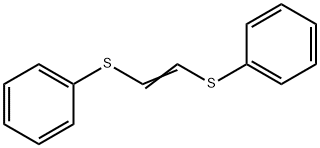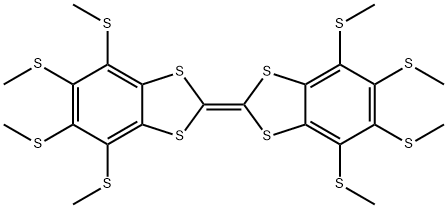Dibenzotetrathiafulvalene
Synonym(s):[2,2’]Bi[benzo[1,3]dithiolylidene];DBTTF
- CAS NO.:24648-13-3
- Empirical Formula: C14H8S4
- Molecular Weight: 304.47
- MDL number: MFCD00443822
- SAFETY DATA SHEET (SDS)
- Update Date: 2023-11-22 13:37:57

What is Dibenzotetrathiafulvalene?
The Uses of Dibenzotetrathiafulvalene
Dibenzotetrathiafulvalene(DBTTF, also known as 1,3-Benzodithiole,2-(1,3-benzodithiol-2-ylidene)-) is an organic electronic material that can be used to form semiconductor charge transfer salts with electron accepting (n-type) materials (TCNQ and F4TCNQ). It can also be used to form charge transfer complexes (TCNQ and DDQ) with a variety of semiconductor crystals for the manufacture of organic field effect transistors (OFETs) and organic light emitting diodes (OLEDs).
Synthesis
Dibenzotetrathiafulvalene was prepared from 2,2'-Bi-1,3-benzodithiol under reaction conditions with 2,3-dicyano-5,6-dichloro-p-benzoquinone and dichloromethane. The specific method of operation is described below:
General procedure: Dithioacetal (0.1 mmol) and DDQ (68 mg, 0.30 mol) were dissolved in CH2Cl2 (3 mL). The resultant dark blue mixture was stirred at room temperature for 16 h and was then washed with a saturated NaOH aqueous solution (2 mL) and CH2Cl2 (10 mL). The orange organic phase was dried over anhydrous Na2SO4, filtered, and then evaporated under reduced pressure. The crude solid was recrystallized from hexane to give the corresponding dibenzotetrathiafulvalene derivative. Dibenzotetrathiafulvalene. Yield: 30 mg (99%); orange solid; mp 239.8-243.0 °C. 1H NMR (500 MHz, CDCl3): δ = 7.27-7.24 (m, 4 H), 7.13-7.10 (m, 4 H). 13C NMR (125 MHz, CDCl3): δ = 136.6, 125.9, 121.9, 110.6. MS (FAB): m/z = 304 [M+]. HRMS (FAB): m/z calcd for [M]+ (C14H8S4): 303.9509; found: 303.9519.
Properties of Dibenzotetrathiafulvalene
| Melting point: | 239-243 °C |
| Boiling point: | 367.1±42.0 °C(Predicted) |
| Density | 1.538±0.06 g/cm3(Predicted) |
Safety information for Dibenzotetrathiafulvalene
| Signal word | Warning |
| Pictogram(s) |
 Environment GHS09 |
| GHS Hazard Statements |
H410:Hazardous to the aquatic environment, long-term hazard |
| Precautionary Statement Codes |
P273:Avoid release to the environment. P501:Dispose of contents/container to..… |
Computed Descriptors for Dibenzotetrathiafulvalene
New Products
4-Aminotetrahydropyran-4-carbonitrile Hydrochloride (R)-3-Aminobutanenitrile Hydrochloride 4-AMINO-TETRAHYDRO-PYRAN-4-CARBOXYLIC ACID HCL 4-(Dimethylamino)tetrahydro-2H-pyran-4-carbonitrile 3-((Dimethylamino)methyl)-5-methylhexan-2-one oxalate 1,4-Dioxa-8-azaspiro[4.5]decane 5-Bromo-2-nitropyridine Nimesulide BP Aceclofenac IP/BP/EP Mefenamic Acid IP/BP/EP/USP Diclofenac Sodium IP/BP/EP/USP Ornidazole IP Diclofenac Potassium SODIUM AAS SOLUTION ZINC AAS SOLUTION BUFFER SOLUTION PH 10.0(BORATE) GOOCH CRUCIBLE SINTERED AQUANIL 5 BERYLLIUM AAS SOLUTION 2-Bromo-1-(bromomethyl)-3-chloro-5-nitrobenzene 2-Bromo-3-nitroaniline N-(3-Hydroxypropyl)-N-methylacetamide 3-Bromo-6-chloropyridazine 4-ethyl-3-nitrobenzoic acidRelated products of tetrahydrofuran





You may like
-
 Dibenzotetrathiafulvalene CAS 24648-13-3View Details
Dibenzotetrathiafulvalene CAS 24648-13-3View Details
24648-13-3 -
 1-Methyl-6-oxo-1,6-dihydropyridazine-3-carbonitrile 98%View Details
1-Methyl-6-oxo-1,6-dihydropyridazine-3-carbonitrile 98%View Details
99903-60-3 -
 1823368-42-8 98%View Details
1823368-42-8 98%View Details
1823368-42-8 -
 2-(3-(tert-butyl)phenoxy)-2-methylpropanoic acid 1307449-08-6 98%View Details
2-(3-(tert-butyl)phenoxy)-2-methylpropanoic acid 1307449-08-6 98%View Details
1307449-08-6 -
 Ethyl 3-(furan-2-yl)-3-hydroxypropanoate 25408-95-1 98%View Details
Ethyl 3-(furan-2-yl)-3-hydroxypropanoate 25408-95-1 98%View Details
25408-95-1 -
 2-Chloro-5-fluoro-1-methoxy-3-methylbenzene 98%View Details
2-Chloro-5-fluoro-1-methoxy-3-methylbenzene 98%View Details
1805639-70-6 -
 1784294-80-9 98%View Details
1784294-80-9 98%View Details
1784294-80-9 -
 Lithium ClavulanateView Details
Lithium ClavulanateView Details
61177-44-4